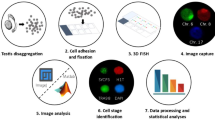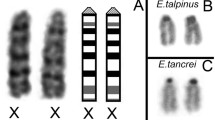Abstract
We have used multicolour fluorescencein situ hybridization to study the behaviour of the X and Y chromosomes in relation to a representative autosome, chromosome 1, on air-dried testicular preparations from normal fertile human males. In a proportion of Sertoli cells at interphase as well as spermatogonial metaphases there is an apparent selective undercondensation of the heterochromatic block of the long arm of the Y, which may be of functional significance with respect to Y-specific gene activity, initiating and maintaining spermatogenesis; we suggest that this may involve a mechanism similar to heterochromatin position-effect variegation inDrosophila. In the supporting Sertoli as well as pre-meiotic and leptotene cells the X and Y occupy relatively restricted domains at opposite poles of the nuclear membrane, while the chromosome 1 centromere regions are located interstitially and appear prealigned. The XY pairing and ‘sex vesicle’ formation comprises a complex series of spatial movement and differential condensation patterns. On the basis of these observations we propose that: the XIST/Xist gene, known to be involved in somatic X inactivation, imposes a chromatin reorganization leading to bending at the X-inactivation centre both at first meiotic prophase in males and in the soma in females; and the differential X and Y segments are protected from potentially deleterious meiotic exchanges by their separate spatial orientation. In addition, there is an indication that the timing of pairing and first meiotic segregation of the sex chromosomes is different, and precocious in comparison to the pairing and segregation of the autosomes, which may explain the high incidence of sex chromosome aneuploidy in sperm.
Similar content being viewed by others
References
Armstrong SJ, Hultén MA (1994) Positional control of meiotic recombination and interference: increased chiasma frequency in the interstitial segments of two human male translocation carriers involving chromosome 9, t(9;10)(p22;q24) and t(9;21)(q21;q11.2) Third International Workshop on Chromosome 9.Am J Hum Genet 58: 201, 1994.
Brown CJ, Hendrich BD, Rupert JLet al. (1992) The human XIST gene: analysis of a 17 Kb inactive X-specific RNA that contains conserved repeats and is highly localised within the nucleus.Cell 71: 527–542.
Chandley AC, Goetz P, Hargreave TB, Joseph AM, Speed RM (1984) On the nature and extent of XY pairing at meiotic prophase in man.Cytogenet Cell Genet 38: 241–247.
Flejter WL, Van Dyke DL, Weiss L (1984) Bends in human mitotic metaphase chromosomes, including a bend marking the X-inactivation center.Am J Hum Genet 36: 218–226.
Freije D, Helms C, Watson MS, Donis-Keller H (1992) Identification of a second peudoautosomal region near the Xq and Yq telomeres.Science 258: 1784–1787.
Goldman ASH, Hultén MA (1992) Chromosomein situ suppression hybridization in human male meiosis.J Med Genet 29: 98–102.
Goldman ASH, Hultén MA (1993a) Meiotic analysis by FISH of a human male 46,XY,t(15;20)(q11.2;q11.2) translocation heterozygote: quadrivalent configuration, orientation and first meiotic segregation.Chromosoma 102: 102–111.
Goldman ASH, Hultén MA (1993b) Analysis of chiasma frequency and first meiotic segregation in a human male reciprocal translocation heterozygote t(1;11)(p36.3;q13.1) using fluorescencein situ hybridisation.Cytogenet Cell Genet 63: 16–23.
Goldman ASH, Formina Z, Knights PA, Hill CJ, Walker AP, Hultén MA (1993) Analysis of the primary sex ratio, sex chromosome aneuploidy and diploidy in human sperm using dual colour fluorescencein situ hybridization.Eur J Hum Genet 1: 325–334.
Guttenbach M, Schmid M, Jauch A, Vogt P (1989) The Y chromosome of the mouse is decondensed in Sertoli cells.Chromosoma 97: 429–433.
Guttenbach M, Winking H, Schmid M (1993) Organization of the Y chromosome in testis cells of fetal, subadult and adult mice as determined byin situ hybridization.Chromosoma 102: 618–622.
Heslop-Harrison JS, Bennett MD (1990) Nuclear architecture in plants.Trends Genet 6: 401–405.
Hultén M, Pearson PL (1971) Fluorescent evidence for spermatocytes with two Y chromosomes in an XYY male.Ann Hum Genet 34: 273.
Hultén M, Lindsten J (1973) Cytogenetic aspects of human male meiosis.Adv Hum Genet 4: 327–387.
Hultén M, Hall J (1990) Proposed meiotic mechanism of genomic imprinting.Chromosomes Today 10: 157–162.
Hultén M, Lindsten J, Ming Pen-Ming L, Fraccaro M (1966) The XY bivalent in human male meiosis.Ann Hum Genet 30: 119–123.
Hultén M, Goldman ASH, Saadallah N, Wallace BNM, Creasy MR (1992) Meiotic studies in man. In: Rooney DE, Czepulddouski BH, eds.Human Cytogenetics. A Practical Approach. Oxford: IRL Press, pp 193–221.
Johannisson R, Froster-Iskenius U, Hultén M (1988) Spermatogenesis in the fragile X mental retardation syndrome: II. Meiosis.J Hum Genet 79: 231–234.
Kvaløy K, Galvagni F, Brown WRA (1994) The sequence organization of the long arm pseudoautosomal region of the human sex chromosomes.Hum Mol Genet 3: 771–778.
Lichter P, Cremer T, Borden J, Manuelidis L, Ward DC (1988) Delineation of individual human chromosomes in metaphase and interphase cells byin situ suppression hybridization using recombinant DNA libraries.Hum Genet 80: 224–234.
McCarrey JR, Dilworth DD (1992) Expression of Xist in mouse germ cells correlates with X-chromosome inactivation.Nature Genet 2: 200–203.
McKee BD, Handel MA (1993) Sex chromosomes, recombination and chromatin conformation.Chromosoma 102: 71–80.
Moore T, Haig D (1991) Genomic imprinting in mammalian development: a parental tug-of-war.Trends Genet 7: 45–49.
Petit C, Levilliers J, Weissenbach J (1988) Physical mapping of the human pseudoautosomal region: comparison with genetic linkage map.EMBO 7: 2369–2376.
Richler C, Soreq H, Wahrman J (1992) X inactivation in mammalian testis is correlated with inactive X-specific transcription.Nature Genet 2: 192–195.
Salido EC, Yen PH, Mohandas TK, Shapiro LJ (1992) Expression of the X-inactivation associated gene Xist during spermatogenesis.Nature Genet 2: 196–199.
Shaffer CD, Wallrath LL, Elgin SCR (1993) Regulating genes by packaging domains: bits of heterochromatin in euchromatin?Trends Genet 9: 35–37.
Speed RM, Vogt P, Köhler MR, Hargreave TB, Chandley AC (1993) Chromatin condensation behaviour of the Y chromosome in the human testis. I. Evidence for decondensation of distal Yq in germ cells prior to puberty with a switch to Sertoli cells in adults.Chromosoma 102: 421–427.
Walker CL, Cargile CB, Floy KM, Delannoy M, Migeon BR (1991) The Barr body is a looped X chromosome formed by telomere association.Proc Natl Acad Sci USA 88: 6191–6195.
Weintraub H, Groudine M (1976) Chromosomal subunits in active genes have an altered conformation.Science 193: 848–856.
Author information
Authors and Affiliations
Rights and permissions
About this article
Cite this article
Armstrong, S.J., Kirkham, A.J. & Hultén, M.A. XY chromosome behaviour in the germ-line of the human male: A FISH analysis of spatial orientation, chromatin condensation and pairing. Chromosome Res 2, 445–452 (1994). https://doi.org/10.1007/BF01552867
Received:
Revised:
Accepted:
Issue Date:
DOI: https://doi.org/10.1007/BF01552867




